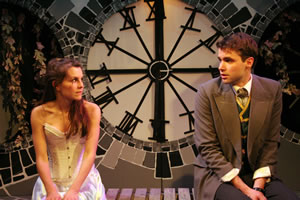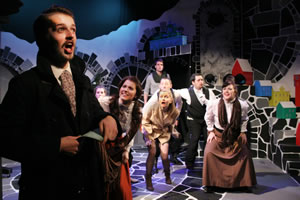Cinderella Provides Excellent Christmas Entertainment
All the better for no crude jokes, minor celebs or panto dames
|
Cinderella at the Tabard is utterly charming, good to look at, sad in parts, hilarious in others and, because it’s by Rodgers & Hammerstein, filled with lots and lots of songs and spiced by some quirkily inventive Tabard touches. All of which adds up to a very pleasant evening, where all ends well in Christmas cheerfulness.

However, don’t go expecting a traditional pantomime. There’s no Widow Twankey, crude jokes, minor celebs or principal boys. It’s excellent Christmas entertainment for grown ups which the kids (particularly the girls) will love too, especially the magic - and I promise you, there is magic. And although it is a Rodgers & Hammerstein musical that was watched by over 60% of the American population on its TV debut in 1957, it doesn’t have lots of well known popular sings. But it has many enjoyable songs and some previously hidden Rodgers & Hammerstein gems, like ‘Do I love you because you are beautiful (or are you beautiful because I love you)’.
As we all know, it starts sadly. Young orphan girl Cinderella, alone in the world and at the mercy of a vicious step-mother and two silly step sisters, lives a life of servitude, at their bullying beck and call. In this version by Alex Young (also the directorial genius behind the recent Tabard hit Ruddigore), there is no masking of the melancholy and cruelty in Cinderella’s life. She is played with touching frailty but underlying resilience by the beautiful Kirsty Mann.
Happily, before the audience is reduced to floods of tears by Cinderella’s sufferings, the scene switches to the village square where, while out being the pack mule to her shopping stepmother and sisters, she meets her Prince Christopher, played charmingly by the very handsome and richly voiced Vlach Ashton. Together they make an attractive couple - but a lot has to happen before that can come about, as we all know.

Lionel, the royal steward, announces a ball at the palace for all the women in the land to meet the Prince. Lionel is played to camp perfection by Josh Carter who makes the most of the role by never going over the top, which would have spoilt it. The ultimate civil servant, he does his job and brooks no argument, his word will be obeyed as he bosses the royal family around. And he gets very touchy if anybody messes with his beautifully coiffed hair.
The ball is the brainchild of the Queen (Sarah Dearlove) and King (Brendan Matthew) who long to hear the patter of tiny feet on the marble and are tired of Christopher’s procrastination when it comes to finding a girl and settling down. Bumbling around the palace together, the King and Queen are obviously still in love, although mildly irritated with each other. (An example of the delicious quirkiness of show is that instead of crowns they wear diamond encrusted goggles).
Helen Colby brilliantly takes a pivotal role as both Cinderella’s stepmother and fairy godmother. She switches from bullying dominatrix in boots with a riding crop and showing too much leg for a woman of her age, to a down-to-earth fairy godmother with a cup of tea, a handbag and speaking estuary English. The fact that the roles of Cinderella’s tormentor and saviour are played by the same person is funny in itself, the way she plays them is even funnier. “Who are you?” asks a distraught Cinderella all alone after her stepmother and step sisters have forbidden her to go to the ball. “A fairy godmother, you got a problem with that?” is the reply. And you have to marvel at how she manages the costume changes in the tiny space behind the stage, particularly as the fairy godmother costume is a particularly big frothy affair.

And with the fairy godmother comes the magic to end the first half as Young and designer Christopher Hone have much fun in transforming pumpkins, mice and a shabby blue dress into carriage, horses and Cinderella in beautiful white ball gown right before our eyes, as the Fairy Godmother tips sparkles from her handbag over Cinderella’s head. It’s no good asking how it was done. Those involved in the show tell you it was magic - and from where I was sitting in the second row, that’s exactly what it looked like. After the magic, everything is ready for Cinderella to go to the ball in the second act.
The generally young, talented cast appeared to be having as good a time as the audience. The two step sisters Grace and Joy (Lydia Jenkins and Kate Scott) are gauche and completely out of their depth in sophisticated company; the excitement brings Grace out in an itchy rash and sets Joy off braying like a donkey. They are a hilarious, ever-fighting double act.
The second half opens in the ballroom as the entire cast, except for Cinderella, dance a gavotte. While all the young women try in vain to catch the Prince’s eye and heart, Cinderella arrives and the romance blossoms to some sumptuous romantic songs.
Watch out for the clock at the back of the stage as the two love birds are canoodling in the garden. It appears from nowhere with a big ominous hand that is ticking the minutes away towards the dreaded midnight hour. Of course Cinderella is having too good a time to notice it, and she has to run away as the clock strikes 12 when she loses her glass slipper. This is found by the meticulous Lionel, and the search for its owner begins. Lots of maidens try to get their feet into the shoe but it will only fit Cinderella and they live happily ever after. And to finish the whole company sings the lovely song ‘There’s Music in You’, together with a hand-clappy encore of one of the show’s songs to send the audience out happy.
Two ‘ensemble’ actors to mention are Paul Dyke and Louise Gookey, who take numerous other parts – the animals, the crowds in the village square, guests at the ball and Louise even gets to try to fit the slipper. And the five-strong band provide a well-rounded platform for the music.
This is another Tabard first - like the Charlie Brown musical a few months ago - as this version hasn’t been seen in London before. The show was written in 1957 for television, then adapted for the stage in 1958 when it came to the London Coliseum with Kenneth Williams, Tommy Steele, Yana and Jimmy Edwards. It was remade in 1997 for Walt Disney Productions, with some songs from the composers’ other shows added (including ‘The Sweetest Sound’, probably the show’s best known song). It’s this 1997 version that makes its London debut at The Tabard.
Penny Flood
December 3, 2011